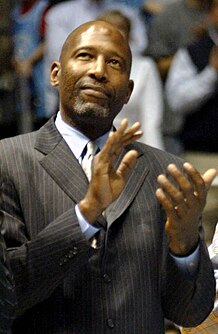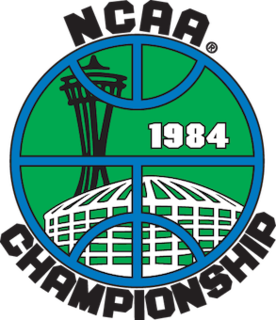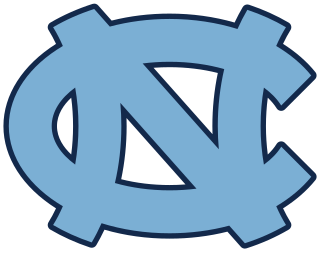
Patrick Aloysius Ewing is a Jamaican-American basketball coach and former professional player who is the head coach of the Georgetown University men's team. He played most of his career as the starting center for the New York Knicks of the National Basketball Association (NBA) before ending his playing career with brief stints with the Seattle SuperSonics and Orlando Magic.

Dean Edwards Smith was an American men's college basketball head coach. Called a "coaching legend" by the Basketball Hall of Fame, he coached for 36 years at the University of North Carolina at Chapel Hill. Smith coached from 1961 to 1997 and retired with 879 victories, which was the NCAA Division I men's basketball record at that time. Smith had the ninth-highest winning percentage of any men's college basketball coach (77.6%). During his tenure as head coach, North Carolina won two national championships and appeared in 11 Final Fours. Smith played college basketball at the University of Kansas, where he won a national championship in 1952 playing for Hall of fame coach Phog Allen.

James Ager Worthy is an American sports commentator, television host, analyst, and former professional basketball player. Nicknamed "Big Game James", he played his entire pro career with the Los Angeles Lakers in the National Basketball Association (NBA). Worthy was a seven-time NBA All-Star who won three NBA championships and was voted the NBA Finals MVP in 1988. He was named to both the NBA's 50th and 75th anniversary teams.

Roy Allen Williams is an American retired college basketball coach who served as the men's head coach for the North Carolina Tar Heels for 18 seasons and the Kansas Jayhawks for 15 seasons. He was inducted into the College Basketball Hall of Fame in 2006 and the Basketball Hall of Fame in 2007.
Matthew Francis Doherty, is an American former college basketball coach best known for his time as head coach of the University of North Carolina Tar Heels men's basketball team. Prior to accepting the head coaching position at UNC he spent one season as head coach of the University of Notre Dame Fighting Irish men's basketball program.

The 1982 NCAA Division I Men's Basketball Tournament involved 48 schools playing in single-elimination play to determine the national champion of men's NCAA Division I college basketball. It began on March 11, 1982, and ended with the championship game on March 29 in the Louisiana Superdome in New Orleans, Louisiana. A total of 47 games were played.

The 1984 NCAA Division I Men's Basketball Tournament involved 53 schools playing in single-elimination play to determine the national champion of men's NCAA Division I college basketball. It began on March 13, 1984, and ended with the championship game on April 2 in Seattle. A total of 52 games were played. This was the last tournament in which some teams earned first-round byes as the field expanded to 64 teams beginning in the 1985 tournament when each team played in the first round. It was also the second year with a preliminary round; preliminary games would not be played again until 2001.

The Georgetown Hoyas men's basketball program represents Georgetown University in NCAA Division I men's intercollegiate basketball and the Big East Conference. Georgetown has competed in men's college basketball since 1907. The current head coach of the program is Patrick Ewing.

The North Carolina Tar Heels are the intercollegiate athletic teams that represent the University of North Carolina at Chapel Hill. The name Tar Heel is a nickname used to refer to individuals from the state of North Carolina, the Tar Heel State. The campus at Chapel Hill is referred to as the University of North Carolina for the purposes of the National Collegiate Athletic Association. The University of North Carolina at Chapel Hill was chartered in 1789, and in 1795 it became the first state-supported university in the United States. Since the school fostered the oldest collegiate team in the Carolinas, the school took on the nickname Carolina, especially in athletics. The Tar Heels are also referred to as UNC or The Heels.

The North Carolina Tar Heels Men's basketball program is the college basketball team of the University of North Carolina at Chapel Hill. The Tar Heels have won six National Collegiate Athletic Association (NCAA) championships, in addition to a Helms Athletic Foundation retroactive title (1924), and participated in a record twenty-one Final Fours. It is the only school to have reached at least one Final Four for nine straight decades and at least two Final Fours for six straight decades, all while averaging more wins per season played (20.7) than any other program in college basketball. In 2012, ESPN ranked North Carolina No. 1 on its list of the 50 most successful programs of the past fifty years.
The 1981–82 North Carolina Tar Heels men's basketball team represented University of North Carolina. The team played its home games in Chapel Hill, North Carolina, and was a member of the Atlantic Coast Conference. Led by James Worthy, Sam Perkins and freshman Michael Jordan, the Tar Heels won the National Championship. It was head coach Dean Smith's first title.

The 1981–82 Georgetown Hoyas men's basketball team represented Georgetown University in the 1981–82 NCAA Division I college basketball season. Led by tenth-year head coach John Thompson, it was the first season in which they played their home games at the Capital Centre in suburban Landover, Maryland, except for five games at McDonough Gymnasium on campus in Washington, D.C.

The 1983–84 Georgetown Hoyas men's basketball team represented Georgetown University in the 1983–84 NCAA Division I college basketball season. John Thompson coached them in his 12th season as head coach. They played their home games at the Capital Centre in Landover, Maryland, except for one game played at McDonough Gymnasium on the Georgetown campus in Washington, D.C. The team was a member of the Big East Conference and finished the season with a record of 34–3 overall, 14–2 in Big East play. They won both the Big East regular-season championship, the 1984 Big East Tournament championship, and they defeated Houston in the 1984 NCAA Tournament final to win the first national championship in Georgetown history.
The 1984–85 Georgetown Hoyas men's basketball team represented Georgetown University in the 1984–85 NCAA Division I college basketball season. John Thompson, coached them in his 13th season as head coach. They played their home games at the Capital Centre in Landover, Maryland. They were members of the Big East Conference and finished the season with a record of 35-3, 14-2 in Big East play. They won the 1985 Big East Men's Basketball Tournament and advanced to the final of the 1985 NCAA Men's Division I Basketball Tournament, which they lost to Big East rival Villanova in what is widely regarded as one of the greatest upsets in college basketball history. They were ranked No. 1 in the season's final Associated Press Poll and Coaches' Poll.
The 1981–82 NCAA Division I men's basketball season began on November 27, 1981, progressed through the regular season and conference tournaments, and concluded with the 1982 NCAA Men's Division I Basketball Tournament Championship Game on March 29, 1982, at the Louisiana Superdome in New Orleans, Louisiana. The North Carolina Tar Heels won their second NCAA national championship with a 63–62 victory over the Georgetown Hoyas.

The 2006–07 Georgetown Hoyas men's basketball team was an NCAA Division I college basketball team competing in the Big East Conference representing Georgetown University. The Hoyas finished first place in the conference, won the conference tournament, and advanced to the semifinals in the NCAA tournament. The 2006–07 season marked the centennial of Hoya hoops, which was celebrated by honoring some of the team's most famous alumni at the Georgetown-Marquette game on February 10, 2007. The team was led by juniors, forward Jeff Green, center Roy Hibbert, and point guard Jonathan Wallace. The team's freshmen were DaJuan Summers, Vernon Macklin, and Jeremiah Rivers. Other regular players are Tyler Crawford, Jessie Sapp, and Patrick Ewing, Jr.

The 1982–83 Georgetown Hoyas men's basketball team represented Georgetown University in the 1982–83 NCAA Division I college basketball season. John Thompson, coached them in his 11th season as head coach. They played their home games at the Capital Centre in Landover, Maryland. They were members of the Big East Conference and finished the season with a record of 22-10 overall, 11-5 in Big East play. They lost to Syracuse in the quarterfinals of the 1983 Big East Tournament and advanced to the second round of the 1983 NCAA Tournament before losing to Memphis State.
The 1984 NCAA Division I Men's Basketball Championship Game was the finals of the 1984 NCAA Division I Men's Basketball Tournament and it determined the national champion for the 1983-84 NCAA Division I men's basketball season The 1984 National Title Game was played on April 2, 1984 at the Kingdome in Seattle, Washington. The 1984 National Title Game was played between the 1984 West Regional Champions, Georgetown and the 1984 Midwest Regional Champions, Houston.










